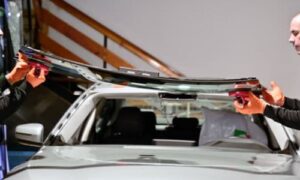Introduction: Tesla is leading in the Electric Car Market
In the dynamic landscape of electric vehicle (EV) sales, Tesla emerged as the undeniable frontrunner in mid-2023. Despite competition from newer entrants, Tesla is leading due to Tesla’s strategic moves, including price reductions and an expansive charging network, which have solidified its position as the leader in the EV race.
1. Unrivaled Sales Performance
In the mid-2023 EV market landscape, Tesla is the frontrunner in sales. Tesla’s prowess in EV sales is undeniable, having sold nearly half a million cars worldwide within the last three months. Surpassing its competitors by a significant margin, Tesla’s Model Y claims the top spot as the world’s best-selling car, underlining its continued market dominance.
According to CNBC, Tesla’s global deliveries were more than 889,000 EVs during the year’s first half, including 466,140 vehicles during the second quarter. Its production is expected to grow, as Tesla aims to produce at least 1.8 million electric cars in 2023.
2. Stalwart Lineup and Winning Tactics
While Tesla’s vehicle lineup may be aging compared to newer competitors, its sales success prevails. The Model Y and Model 3, introduced in 2020 and 2017, respectively, remain in high demand due to their remarkable driving experience and long-range capabilities. This enduring appeal is complemented by Tesla’s strategic price reductions, ensuring their vehicles remain attractive in a competitive market.
3. The Power of the Charging Network
Its extensive and efficient charging network is a notable factor that keeps Tesla ahead. Competing manufacturers, including GM, Ford, Volvo, and Mercedes-Benz, are adopting Tesla’s charging standard in North America. This strategic decision allows buyers of various EV brands to access Tesla’s well-established charging infrastructure, potentially boosting EV adoption across the board.
4. Leveraging Tax Incentives
Tesla’s agility in adapting to the changing market dynamics is evident through its effective use of tax incentives. The company has taken full advantage of EV tax credits, positioning its vehicles at competitive prices and enticing buyers. By reducing costs while maintaining profitability, Tesla sets itself apart from other automakers struggling to navigate the economics of EV production.
5. Navigating Challenges and Future Prospects
Tesla’s continued leadership is not without challenges. The delay of the Cybertruck, while reminiscent of the gaming world’s Half-Life 3, showcases that even innovative companies face setbacks. Additionally, a growing mismatch between EV supply and demand raises questions about the industry’s ability to meet consumer needs effectively.
6. Pivoting to an Electrified Future
Tesla’s dominance highlights other automakers’ complexities in transitioning to an all-electric future. Traditional manufacturers must recalibrate their design, production, and sales processes while confronting the delicate balance between meeting environmental goals and satisfying shareholders.
7. Sustainable Profitability Amidst Price Cuts
Despite implementing substantial price cuts, Tesla’s profitability remains intact. This ability to slash prices without compromising the bottom line underscores the company’s efficiency in production and operations, setting it apart from competitors struggling to find the same balance. Tesla’s strategic price reductions have bolstered its position. Even with its older models, the company slashed prices significantly, making the most of available EV tax credits.
8. EV Tax Credit Dynamics
Tesla’s strategic positioning to benefit from EV tax credits has been pivotal in its continued leadership. By meeting the criteria for tax incentives and leveraging them effectively, Tesla ensures that its vehicles remain attractive to cost-conscious consumers, giving it an edge in the competitive market. The current EV supply and demand mismatch is notable, with EVs spending twice as long on dealer lots as gasoline cars. Stringent “buy local” rules for EV tax credits have inadvertently hindered demand, impacting automakers like BMW, Volvo, and Hyundai.
9. The Role of Charging Infrastructure
One of Tesla’s pivotal strengths is its expansive charging network. This network facilitates long-distance travel and serves as a sign of Tesla’s dominance. Major automakers, including GM, Ford, Volvo, Rivian, and Mercedes-Benz, have utilized Tesla’s charging standard, recognizing its superiority.
As other manufacturers tap into Tesla’s charging standard, the company stands to gain substantial income from both public funding for charging stations and the charging transactions themselves.
10. Market Impact of Environmental Pledges
Tesla’s leading focus on electrification contrasts traditional automakers’ challenges in reconciling environmental pledges with profit-driven strategies.
Car manufacturers grapple with reconciling environmental pledges with profitability. Notable companies like General Motors and Volkswagen face delays and challenges transitioning to all-electric lineups due to complex manufacturing changes and market realities.
Tesla’s Charging Network Monetization
Tesla’s charging network offers a dual benefit: enhanced customer experience and potential revenue. Tesla taps into public funding and charging-related revenue by providing charging infrastructure to other automakers, possibly outweighing any possible sales loss to competitors.
Outperforming the Competition
Comparing Tesla’s sales to the rest of the EV market reveals a substantial gap. The Chevrolet Bolt, a commendable yet soon-to-be-discontinued EV, secured the third spot after Tesla’s Model Y and Model 3. Notably, Tesla’s Model Y outsold the Bolt by almost six times, underscoring Tesla’s market dominance.
Future Prospects
Considering the current landscape, it’s unlikely that Tesla’s EV dominance will waver in the short term. Radical price cuts or groundbreaking battery technology would be required to disrupt its position. With a strong charging network, strategic pricing, and a reputation for innovation, Tesla’s leadership in the EV race appears secure.
Conclusion: Tesla is leading in the Electric Car Race
With its well-established charging network, strategic pricing, and adaptability to changing market conditions, Tesla is the leader in the electric car manufacturing race. While facing challenges and uncertainties, Tesla’s winning strategies and commitment to innovation continue to drive its success, making it a formidable force in the automotive industry’s electrified future.



